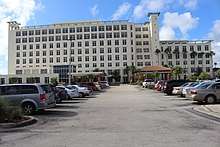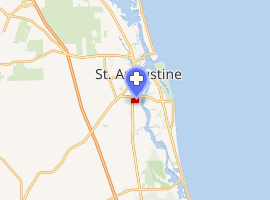Flagler Hospital
Flagler Hospital, based in St. Augustine, Florida, is a not-for-profit facility established in 1889. The organization offers "Centers of Excellence" in bariatrics, heart, cancer, maternity, orthopedics and sinus.[2]
| Flagler Hospital | |
|---|---|
 | |
 | |

| |
| Geography | |
| Location | St. Augustine, Florida, United States |
| Coordinates | 29.863144°N 81.317604°W |
| Organization | |
| Care system | Medicare/Medicaid/Public |
| Type | General medical and surgical |
| Services | |
| Emergency department | yes |
| Beds | 316[1] |
| History | |
| Opened | as Alicia Hospital on March 1, 1890 |
| Links | |
| Website | www.flaglerhospital.org |
| Lists | Hospitals in Florida |
History
Alicia Hospital
In the 1880s, there was no public hospital between Daytona Beach and Jacksonville. Dr. Sloggett purchased a house on Marine Street for his home in 1884, but his goal was to eventually transform the structure into a hospital.[3]
The children of the St. Augustine Loyal Temperance held a fair at the Union chapel on April 7, 1888. Their intent was to raise money for a hospital in St. Augustine.[3] Winter resident Henry Flagler became interested in the issue. On May 22, 1888 he invited St. Augustine's most influential women to his Ponce de León Hotel and offered them a hospital if the community would commit to operate and manage the facility. The ladies accepted his offer, then began soliciting contributions and organizing fund-raisers.[4] Dr. Andrew Anderson was named chairman of the board of trustees in 1889. Flagler purchased and deeded the property and building on Marine Street to the St. Augustine Hospital Association, and the facility opened March 1, 1890 as a non-profit institution, serving whites only (some hospitals in Florida were not fully integrated until the 1970s). Physician and St. Augustine mayor DeWitt Webb also practiced there.
In 1905, the name of the facility was changed to "Flagler Hospital" in honor of their first benefactor.[3][5]
Flagler Hospital
A training school for nurses was started in 1913.[4]
A 1916 fire destroyed many of the hospital's structures. Nearby local residents took the patients into their homes until they could be placed elsewhere. The hospital association began making plans for a new structure, but nearly five years passed before it became reality. Henry Flagler died in 1913; his third wife, Mary Lily Kenan Flagler, donated money to construct a brick structure with three floors which was dedicated January 5, 1921.[4]
During the 1930s, hospital admissions averaged between 60 and 70 admissions each month. A new Florida law was passed in 1932 which required that medical training schools be associated with multiple hospitals, so the nurses training program was discontinued after nearly 20 years.[4]
During World War II, there was a big increase in admissions, with almost 40 births per month. The hospital was forced to raise prices to pay for higher supply costs.[4]
The future looked bright in the 1950s. To meet the increasing demand for healthcare, the hospital's south wing was renovated, providing room for a clinic and doctor offices. A modern laboratory was built, as were hydrotherapy and physiotherapy rooms.[4]
The Florida East Coast Railway Hospital was founded in St. Augustine in 1891 to care for Florida East Coast Railway employees and family members.[6] In the early 1960s, that hospital announced that they would be closing, which provided Flagler Hospital time to prepare for more patients. Flagler Hospital built a West wing and remodeled its existing facility.[4]
Medical specialists were drawn to the area during the 70s, and the Anderson-Gibbs Annex was built to accommodate their needs. The hospital was expanded to provide more surgical capacity and an in-house psychiatric services center was established to serve the area. Demand for cardiac services prompted the trustees to develop a cardiac care program in 1979. Pulmonary diagnostic procedures came next.[4]
The St. Johns County population exceeded 50,000 during the 1980s, and the Marine street facility was no longer adequate. Planning began for a new health park on a more accessible 75-acre parcel along the east side of U.S. Highway 1. The move to the new location was completed in 1989.[7] Two years later, Flagler merged with St. Augustine General Hospital, doubling the number of patient beds from 150 to over 300.
Today
Leadership
As Flagler's risk manager for 25 years, Joe Gordy considered quality patient care a top priority. When Gordy was named CEO in 2003, he faced several pressing issues including patient satisfaction. A survey of Emergency Room patients gave the hospital a score of 5 out of 100. To turn the trend around, he used the Best practice method. Gordy researched the hospitals that had achieved the top national rankings in ER satisfaction, and from them, he picked a Florida hospital to study. Gordy saw that patient anxiety increased while they sat with nothing to do and waited for service. Televisions were installed in examination rooms to provide a distraction. A different strategy was required to reduce wait times. Most ER visits were not true emergencies, but the care they provide is expensive, costing at least $500 per visit. People without health insurance were using the ER as their family doctor, creating unnecessary expenses and service delays. To help alleviate the situation, the hospital opened a primary care clinic next door to the emergency room in 2004. The facility treats 8,000 patients per year for fees that are a fraction of what is charged in the ER. To help motivate the staff, he changed their mission statement to: Providing the best patient experience with the best staff. The efforts paid off; surveys in 2005 were at or above the 90th percentile with a 98 in December.[8] The hospital was also named to Solucient's "100 Most Improved Hospitals" for 2005,[9] 2006,[10] and 2007.[11]
Divestiture
In November 2005, Flagler sold its Community Home Health unit, which provides home visits by a nurse, to Almost Family, Inc.[12]
Plans
Prior to the recession of 2008, the hospital announced plans to build a $30 million medical park at the World Commerce Center.[13] Twelve acres were purchased for $2 million in early 2005, and the project was to be built in stages over two years. Phase I was a 10,000 ft2 urgent care center costing $5 million, followed by phase II, a 3,400 ft2 condominium building of doctor's offices. The final element was to be a 43,000 ft2 ambulatory surgery center.[14] As of 2011, the project was still on hold.
Specialties
The hospital has a 14-bed nursing home unit that was rated above average on October 5, 2010 from CMS of the Department of Health and Human Services.[15]
Flagler has centers of excellence in Imaging, Bariatrics, Cancer, Heart, Spine, Maternity, Orthopedics and Sinus.[2]
Hospice
The Bailey Family Center for Caring was opened on January 8, 2011 on the Flagler Hospital campus. The 12-bed, 11,700-square-foot (1,090 m2) facility is the first inpatient hospice center in St. Johns County, Florida and the fifth for Community Hospice of Northeast Florida.[16][17]
Blood bank
Flagler Hospital was the primary user of services from the St. Johns County Blood Bank. In 1988, they partnered to construct a 4,000-square-foot (370 m2) facility on the Flagler Hospital campus.[18] They merged with Jacksonville's Florida Georgia Blood Alliance on February 20, 2005. The resulting Blood Alliance at Flagler Hospital reduced costs and increased the use of technology while continuing to provide blood service to Flagler Hospital.[19]
Alleged honors
- Included on list of America's Best Hospitals in 2007 by U.S. News & World Report.[20]
- Outstanding Achievement Award in 2008 from the Commission on Cancer.[20]
- Gold Seal of Approval and Primary Stroke Care Center Designation by the Joint Commission.[20]
- Accredited by the Commission on Cancer of the American College of Surgeons.[20]
- Named a Bariatric Surgery Center of Excellence by the American Society of Metabolic and Bariatric Surgery.[20]
- Accredited by American Academy of Sleep Medicine.[20]
- Certified by the American Association of Cardiovascular and Pulmonary Rehabilitation.[20]
- Identified as north Florida's first Magnet hospital by the American Nurses Credentialing Center.[20]
- Named by HealthGrades as one of America's Best 50 Hospitals in 2011.[20]
- Distinguished Hospital and Patient Safety Excellence Award from HealthGrades for seven consecutive years.[20]
- Named a "Best place to work in northeast Florida" by the Jacksonville Business Journal.[8]
- One of Solucient's (now Thomson Reuters) "100 most improved Hospitals" for 2005,[9] 2006,[10] 2007,[11] and 2008.[20]
References
- "Flagler Hospital" US News & World Report
- "Hospital overview" Flagler Hospital website
- Wilson, Gil: "Alicia Hospital" Dr. Bronson's History of St. Augustine
- "Hospital History" Flagler Hospital website
- Adams, William R.: St. Augustine and St. Johns County: A Historical Guide ISBN 1-56164-432-3, page 60
- "Florida East Coast Railway Hospital" Dr. Bronson's St. Augustine History
- "Flagler Hospital" HealthGrades, Hospital profiles
- "Flagler Hospital" Inside Healthcare, June 1, 2006
- "Majority of U.S. Hospitals Showed No Appreciable Change in Hospital-Wide Performance Since 2000" Archived 2012-04-25 at the Wayback Machine Solucient press release, May 1, 2006
- "For Those Hospitals Improving in Quality and Efficiency, Outpatient Growth Is a Key Business Outcome" Archived 2012-04-25 at the Wayback Machine Solucient press release, August 6, 2007
- "Hospitals in Texas, Florida and New York Set Pace for Improved Performance" Archived 2012-06-16 at the Wayback Machine Thomson-Reuters press release, August 11, 2008
- "Almost Family Inc acquires Community Home Health from Flagler Hospital,FL" Alacra Business Info
- "World Commerce Center mall planned" Jacksonville Business Journal, April 16, 2007
- Guinta, Peter: "Flagler Hospital expanding into World Golf Village" St. Augustine Record, October 18, 2005
- "Flagler Hospital" U Compare health ratings
- "Bailey Family Center for Caring" Archived 2011-10-11 at the Wayback Machine Community Hospice website
- "Bailey Family Center for Caring previewed" St. Augustine Record, January 6, 2011M
- "110 Health Park Blvd" St. Johns County Property Appraiser website
- "Merger proves beneficial for blood donors, patients" St. Augustine Record, November 14, 2006
- "Awards and Recognition" Flagler Hospital website